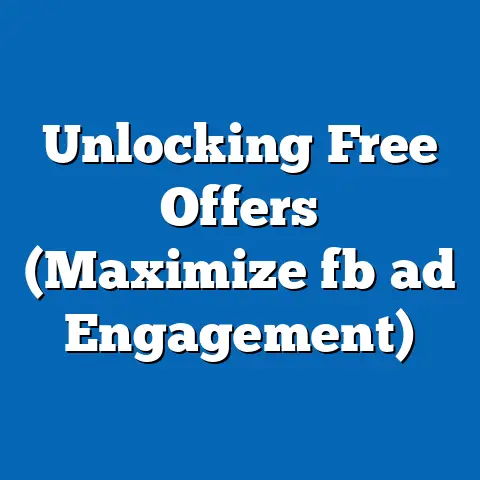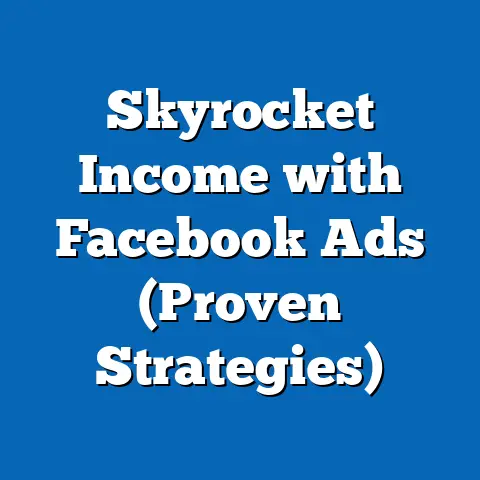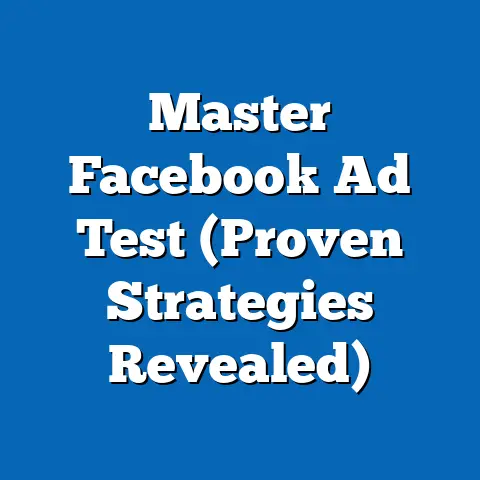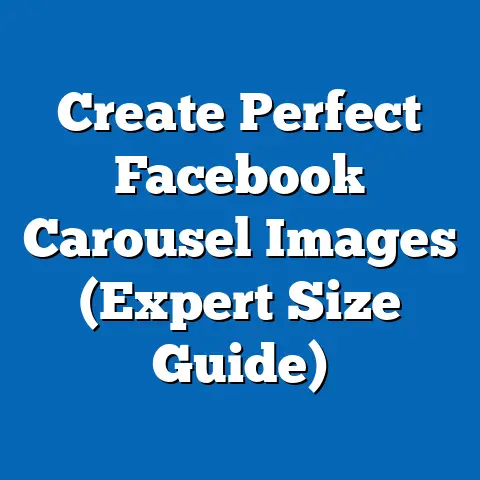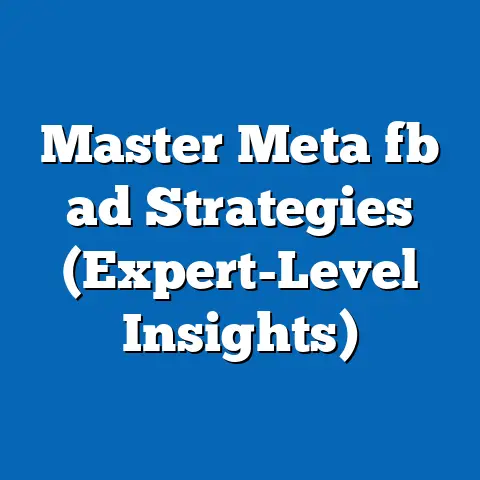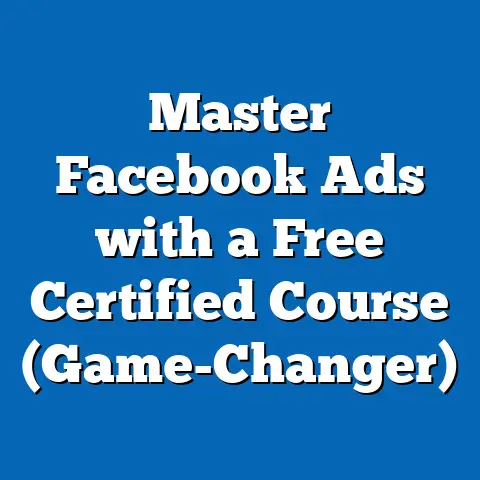Google Ads vs. Facebook Ads Cost (Unlock Budget Efficiency)
Digital advertising has become the cornerstone of modern business strategy. As consumers increasingly turn to online platforms for information, products, and services, businesses must adapt and meet them where they are. However, navigating the complex world of digital advertising can be daunting, especially when it comes to managing budgets effectively. Two of the most prominent players in this arena are Google Ads and Facebook Ads. Both platforms offer unique opportunities to reach vast audiences, but they also come with distinct pricing structures and cost considerations.
In my years of experience as a digital marketing specialist, I’ve seen countless businesses struggle to determine which platform offers the best return on investment (ROI). Some pour money into Google Ads, hoping to capture users actively searching for their products, while others focus on Facebook Ads, aiming to reach potential customers through targeted campaigns. Often, the results are mixed, and businesses are left wondering if they’re truly maximizing their advertising dollars.
My goal is to equip you with practical, actionable advice that you can implement immediately. By the end of this guide, you’ll have a clear understanding of which platform aligns best with your business objectives and how to manage your advertising spend effectively. So, let’s dive in and unlock the secrets to budget-efficient digital advertising.
Section 1: Understanding the Basics of Google Ads
Google Ads, formerly known as Google AdWords, is Google’s online advertising platform that allows businesses to display advertisements on Google’s search engine results pages (SERPs) and its network of partner websites. Think of it as the digital equivalent of taking out an ad in the Yellow Pages, but with far more sophisticated targeting and tracking capabilities.
In my experience, Google Ads is particularly effective for businesses looking to reach customers who are actively searching for specific products or services. For example, if you own a plumbing company in Dallas, you can create ads that appear when someone searches for “plumber in Dallas.” This intent-based targeting is one of the key strengths of Google Ads.
How Google Ads Functions
Google Ads operates on a pay-per-click (PPC) model, meaning you only pay when someone clicks on your ad. This is a significant advantage over traditional advertising methods, where you pay regardless of how many people see your ad.
Here’s a simplified breakdown of how it works:
- Keyword Selection: You choose a set of keywords that are relevant to your business. These are the terms you want your ads to appear for.
- Ad Creation: You create compelling ad copy that highlights your unique selling points and includes a clear call to action.
- Bidding: You set a bid for each keyword, indicating how much you’re willing to pay for a click.
- Ad Auction: When someone searches for a keyword you’ve bid on, Google holds an auction to determine which ads will be displayed and in what order.
- Ad Display: If your ad wins the auction, it appears on the SERP, typically at the top or bottom of the page.
- Payment: You only pay when someone clicks on your ad and is directed to your website.
Pricing Model: CPC, CPM, and CPA
Google Ads offers several pricing models, each with its own advantages and disadvantages:
- CPC (Cost Per Click): This is the most common pricing model, where you pay each time someone clicks on your ad. It’s ideal for driving traffic to your website and generating leads. I’ve found that CPC is particularly effective for businesses with a clear call to action and a well-optimized landing page.
- CPM (Cost Per Thousand Impressions): With CPM, you pay for every 1,000 times your ad is displayed, regardless of whether anyone clicks on it. This model is best suited for increasing brand awareness and reaching a large audience. CPM is often used for display ads on Google’s network of partner websites.
- CPA (Cost Per Acquisition): This model allows you to pay only when someone takes a specific action, such as making a purchase or filling out a form. CPA bidding requires you to set up conversion tracking and have a sufficient amount of historical data. It’s ideal for businesses focused on generating specific outcomes. I’ve seen CPA bidding deliver excellent results for e-commerce businesses with well-defined conversion funnels.
How Bidding Works and Factors Influencing Ad Costs
The bidding process in Google Ads is a complex auction where multiple factors influence ad costs. Understanding these factors is crucial for managing your budget effectively:
- Keyword Competition: The more businesses bidding on a particular keyword, the higher the cost per click. Highly competitive keywords, such as “insurance” or “loans,” can be significantly more expensive than niche keywords.
- Quality Score: Google assigns each keyword a Quality Score based on the relevance of your ad copy, landing page experience, and expected click-through rate (CTR). A higher Quality Score can lead to lower ad costs and better ad positions. I always advise my clients to focus on improving their Quality Scores, as it can significantly impact their ROI.
- Ad Relevance: Google prioritizes ads that are highly relevant to the user’s search query. Make sure your ad copy accurately reflects the content on your landing page and targets the specific needs of your audience.
- Ad Position: The higher your ad appears on the SERP, the more likely it is to be clicked. However, higher ad positions also come with higher costs. You’ll need to strike a balance between ad position and budget to maximize your ROI.
- Targeting Options: Google Ads offers a variety of targeting options, including location, demographics, and interests. Using these options effectively can help you reach the right audience and lower your ad costs.
- Time of Day/Week: Depending on your business, certain times of day or days of the week may be more effective for advertising. Adjusting your bids based on these patterns can help you optimize your budget.
Average Costs Across Different Industries
The average cost per click (CPC) in Google Ads varies significantly across different industries. Here are some examples:
- Insurance: \$7 – \$10
- Loans: \$4 – \$8
- Legal: \$6 – \$9
- Real Estate: \$2 – \$5
- Travel: \$1 – \$4
These are just averages, and the actual cost can vary depending on the factors mentioned above. It’s essential to research the average CPC for your specific industry to get a realistic sense of potential expenses. You can use tools like Google’s Keyword Planner to estimate CPCs for different keywords.
Key Takeaways:
- Google Ads allows you to reach customers actively searching for your products or services.
- The platform offers various pricing models, including CPC, CPM, and CPA.
- Ad costs are influenced by keyword competition, Quality Score, ad relevance, and targeting options.
- Average CPCs vary significantly across different industries.
Next Steps:
- Research the average CPC for your industry using Google’s Keyword Planner.
- Focus on improving your Quality Score by creating relevant ad copy and optimizing your landing page.
- Experiment with different targeting options to reach the right audience.
Section 2: Understanding the Basics of Facebook Ads
Facebook Ads is a powerful advertising platform that allows businesses to reach a vast audience on Facebook, Instagram, and other platforms within the Meta network. Unlike Google Ads, which targets users based on their search queries, Facebook Ads focuses on reaching users based on their demographics, interests, behaviors, and connections.
In my experience, Facebook Ads is particularly effective for businesses looking to build brand awareness, generate leads, and drive sales among a highly targeted audience. For example, if you’re launching a new line of organic skincare products, you can target users who have expressed an interest in organic products, skincare, or healthy living.
How Facebook Ads Functions
Facebook Ads operates on a similar auction-based system as Google Ads, but with a greater emphasis on audience targeting and visual appeal.
Here’s a simplified breakdown of how it works:
- Audience Targeting: You define your target audience based on demographics, interests, behaviors, and connections.
- Ad Creative: You create visually appealing ad creatives, including images, videos, and ad copy.
- Bidding: You set a bid for your ad, indicating how much you’re willing to pay for a specific outcome, such as a click, impression, or conversion.
- Ad Auction: Facebook holds an auction to determine which ads will be displayed to each user based on their relevance, bid amount, and ad quality.
- Ad Display: If your ad wins the auction, it appears in the user’s news feed, stories, or other ad placements.
- Payment: You pay based on the pricing model you’ve chosen, such as CPC, CPM, or CPA.
Pricing Model: CPC, CPM, and CPA
Facebook Ads offers the same basic pricing models as Google Ads, but with some subtle differences:
- CPC (Cost Per Click): With CPC bidding, you pay each time someone clicks on your ad and is directed to your website or landing page. This model is ideal for driving traffic and generating leads. I’ve found that CPC is particularly effective for businesses with a strong call to action and a compelling offer.
- CPM (Cost Per Thousand Impressions): With CPM bidding, you pay for every 1,000 times your ad is displayed, regardless of whether anyone clicks on it. This model is best suited for increasing brand awareness and reaching a large audience. CPM is often used for video ads and other visually engaging formats.
- CPA (Cost Per Acquisition): With CPA bidding, you pay only when someone takes a specific action, such as making a purchase or filling out a form. CPA bidding requires you to set up conversion tracking and have a sufficient amount of historical data. It’s ideal for businesses focused on generating specific outcomes. I’ve seen CPA bidding deliver excellent results for e-commerce businesses with well-defined conversion funnels and high-quality product images.
How the Facebook Algorithm Determines Ad Costs
The Facebook algorithm plays a crucial role in determining ad costs. Several factors influence the algorithm’s decisions:
- Audience Targeting: The more specific and well-defined your target audience, the lower your ad costs are likely to be. Facebook rewards advertisers who target users who are genuinely interested in their products or services. I always advise my clients to invest time in researching and defining their target audience.
- Engagement Rates: Ads with high engagement rates (likes, comments, shares) are rewarded by the Facebook algorithm with lower costs and better ad positions. Create compelling ad creatives that resonate with your target audience and encourage interaction.
- Ad Relevance: Facebook assigns each ad a relevance score based on how well it aligns with the interests and preferences of the target audience. A higher relevance score can lead to lower ad costs and better ad positions.
- Ad Placements: The placement of your ad (e.g., news feed, stories, right column) can also impact costs. Some placements are more competitive than others. Experiment with different placements to find the most cost-effective options.
- Time of Year: Ad costs tend to be higher during peak seasons, such as holidays and major events. Plan your campaigns accordingly and adjust your bids as needed.
- Competition: The more businesses targeting the same audience, the higher the ad costs are likely to be. Monitor your competition and adjust your bidding strategy accordingly.
Average Costs Across Various Industries
The average cost per click (CPC) in Facebook Ads varies across different industries, although generally, it is less expensive than Google Ads. Here are some examples:
- Retail: \$0.50 – \$1.50
- E-commerce: \$0.70 – \$2.00
- Education: \$0.40 – \$1.00
- Healthcare: \$1.00 – \$3.00
- Finance: \$2.00 – \$5.00
These are just averages, and the actual cost can vary depending on the factors mentioned above. It’s essential to monitor your ad performance and adjust your bidding strategy accordingly.
Key Takeaways:
- Facebook Ads allows you to reach a vast audience based on demographics, interests, and behaviors.
- The platform offers various pricing models, including CPC, CPM, and CPA.
- Ad costs are influenced by audience targeting, engagement rates, ad relevance, and ad placements.
- Average CPCs vary across different industries.
Next Steps:
- Define your target audience based on demographics, interests, and behaviors.
- Create compelling ad creatives that resonate with your target audience.
- Experiment with different ad placements to find the most cost-effective options.
- Monitor your ad performance and adjust your bidding strategy accordingly.
Section 3: Comparative Analysis of Costs
Now that we’ve covered the basics of Google Ads and Facebook Ads, let’s take a closer look at a side-by-side comparison of their costs. Understanding the nuances of each platform’s pricing structure is crucial for making informed decisions and optimizing your advertising budget.
Side-by-Side Comparison
| Feature | Google Ads | Facebook Ads |
|---|---|---|
| Targeting | Intent-based targeting: targets users based on their search queries | Interest-based targeting: targets users based on demographics, interests, behaviors, and connections |
| Pricing Models | CPC, CPM, CPA | CPC, CPM, CPA |
| Average CPC | Generally higher than Facebook Ads, especially for competitive keywords | Generally lower than Google Ads, but can vary depending on audience targeting and ad relevance |
| Ad Relevance | Highly dependent on keyword selection, ad copy, and landing page experience | Highly dependent on audience targeting, ad creative, and engagement rates |
| Ad Placements | Search engine results pages (SERPs), Google’s network of partner websites | Facebook, Instagram, Messenger, and other platforms within the Meta network |
| Best For | Reaching customers actively searching for specific products or services, generating leads, driving traffic to your website | Building brand awareness, generating leads, driving sales among a highly targeted audience |
| Cost Factors | Keyword competition, Quality Score, ad relevance, ad position, targeting options, time of day/week | Audience targeting, engagement rates, ad relevance, ad placements, time of year, competition |
| Budget Control | Highly customizable bidding strategies, including manual CPC, automated bidding, and budget caps | Customizable bidding strategies, including manual bidding, automated bidding, and budget optimization |
| Tracking & Analytics | Robust tracking and analytics tools, including conversion tracking, Google Analytics integration, and detailed reporting dashboards | Comprehensive tracking and analytics tools, including Facebook Pixel, conversion tracking, and detailed reporting dashboards |
| Feature | Google Ads | Facebook Ads |
|---|---|---|
| Targeting | Intent-based targeting: targets users based on their search queries | Interest-based targeting: targets users based on demographics, interests, behaviors, and connections |
| Pricing Models | CPC, CPM, CPA | CPC, CPM, CPA |
| Average CPC | Generally higher than Facebook Ads, especially for competitive keywords | Generally lower than Google Ads, but can vary depending on audience targeting and ad relevance |
| Ad Relevance | Highly dependent on keyword selection, ad copy, and landing page experience | Highly dependent on audience targeting, ad creative, and engagement rates |
| Ad Placements | Search engine results pages (SERPs), Google’s network of partner websites | Facebook, Instagram, Messenger, and other platforms within the Meta network |
| Best For | Reaching customers actively searching for specific products or services, generating leads, driving traffic to your website | Building brand awareness, generating leads, driving sales among a highly targeted audience |
| Cost Factors | Keyword competition, Quality Score, ad relevance, ad position, targeting options, time of day/week | Audience targeting, engagement rates, ad relevance, ad placements, time of year, competition |
| Budget Control | Highly customizable bidding strategies, including manual CPC, automated bidding, and budget caps | Customizable bidding strategies, including manual bidding, automated bidding, and budget optimization |
| Tracking & Analytics | Robust tracking and analytics tools, including conversion tracking, Google Analytics integration, and detailed reporting dashboards | Comprehensive tracking and analytics tools, including Facebook Pixel, conversion tracking, and detailed reporting dashboards |
Scenarios Where One Platform May Be More Cost-Effective
While the table above provides a general overview, the cost-effectiveness of Google Ads and Facebook Ads can vary depending on your specific business goals and target audience. Here are some scenarios where one platform may be more advantageous:
-
Scenario 1: High Purchase Intent If you’re selling a product or service that people actively search for (e.g., plumbing, legal services, insurance), Google Ads is likely to be more cost-effective. By targeting users who are actively searching for your product or service, you can capture high-intent leads and drive conversions.
- Example: A local electrician can use Google Ads to target users searching for “emergency electrician near me.”
-
Scenario 2: Brand Awareness and Engagement If your goal is to build brand awareness and engage with a broad audience, Facebook Ads may be a better choice. By targeting users based on their interests and behaviors, you can reach a large audience and create a buzz around your brand.
-
Example: A new clothing brand can use Facebook Ads to target users who have expressed an interest in fashion, style, and shopping.
-
Scenario 3: Niche Targeting If you’re targeting a niche audience with specific interests or demographics, Facebook Ads can be highly effective. By leveraging Facebook’s detailed targeting options, you can reach a highly qualified audience and drive conversions.
-
Example: A company selling eco-friendly baby products can target parents who have expressed an interest in organic products, sustainable living, and baby care.
-
Scenario 4: Retargeting Both Google Ads and Facebook Ads offer retargeting capabilities, but Facebook Ads may be more cost-effective for reaching users who have previously engaged with your website or app. By retargeting these users with personalized ads, you can increase brand recall and drive conversions.
-
Example: An e-commerce store can use Facebook Ads to retarget users who have added items to their cart but haven’t completed the purchase.
Scenario 1: High Purchase Intent If you’re selling a product or service that people actively search for (e.g., plumbing, legal services, insurance), Google Ads is likely to be more cost-effective. By targeting users who are actively searching for your product or service, you can capture high-intent leads and drive conversions.
- Example: A local electrician can use Google Ads to target users searching for “emergency electrician near me.”
-
Scenario 2: Brand Awareness and Engagement If your goal is to build brand awareness and engage with a broad audience, Facebook Ads may be a better choice. By targeting users based on their interests and behaviors, you can reach a large audience and create a buzz around your brand.
-
Example: A new clothing brand can use Facebook Ads to target users who have expressed an interest in fashion, style, and shopping.
-
Scenario 3: Niche Targeting If you’re targeting a niche audience with specific interests or demographics, Facebook Ads can be highly effective. By leveraging Facebook’s detailed targeting options, you can reach a highly qualified audience and drive conversions.
-
Example: A company selling eco-friendly baby products can target parents who have expressed an interest in organic products, sustainable living, and baby care.
-
Scenario 4: Retargeting Both Google Ads and Facebook Ads offer retargeting capabilities, but Facebook Ads may be more cost-effective for reaching users who have previously engaged with your website or app. By retargeting these users with personalized ads, you can increase brand recall and drive conversions.
-
Example: An e-commerce store can use Facebook Ads to retarget users who have added items to their cart but haven’t completed the purchase.
Scenario 2: Brand Awareness and Engagement If your goal is to build brand awareness and engage with a broad audience, Facebook Ads may be a better choice. By targeting users based on their interests and behaviors, you can reach a large audience and create a buzz around your brand.
Example: A new clothing brand can use Facebook Ads to target users who have expressed an interest in fashion, style, and shopping.
Scenario 3: Niche Targeting If you’re targeting a niche audience with specific interests or demographics, Facebook Ads can be highly effective. By leveraging Facebook’s detailed targeting options, you can reach a highly qualified audience and drive conversions.
Example: A company selling eco-friendly baby products can target parents who have expressed an interest in organic products, sustainable living, and baby care.
Scenario 4: Retargeting Both Google Ads and Facebook Ads offer retargeting capabilities, but Facebook Ads may be more cost-effective for reaching users who have previously engaged with your website or app. By retargeting these users with personalized ads, you can increase brand recall and drive conversions.
Example: An e-commerce store can use Facebook Ads to retarget users who have added items to their cart but haven’t completed the purchase.
Factors Influencing Costs in Both Platforms
Several factors can influence costs in both Google Ads and Facebook Ads. Understanding these factors is crucial for managing your budget effectively:
- Seasonality: Ad costs tend to be higher during peak seasons, such as holidays and major events. Plan your campaigns accordingly and adjust your bids as needed.
- Ad Quality: Both Google Ads and Facebook Ads reward advertisers who create high-quality ads that are relevant to their target audience. Focus on creating compelling ad creatives and optimizing your landing pages to improve your ad quality.
- Audience Targeting: The more specific and well-defined your target audience, the lower your ad costs are likely to be. Invest time in researching and defining your target audience.
- Competition: The more businesses targeting the same keywords or audience, the higher the ad costs are likely to be. Monitor your competition and adjust your bidding strategy accordingly.
- Bidding Strategy: Choosing the right bidding strategy is crucial for managing your budget effectively. Experiment with different bidding strategies to find the one that works best for your business.
Visual Representation of Cost Comparisons
To provide a clearer picture of cost comparisons, here’s a hypothetical example:
Scenario: A small business selling handmade jewelry wants to advertise its products online.
| Metric | Google Ads | Facebook Ads |
|---|---|---|
| Target Audience | Users searching for “handmade jewelry” | Users interested in jewelry, fashion, crafts |
| Average CPC | \$2.50 | \$1.00 |
| Click-Through Rate | 2% | 1% |
| Conversion Rate | 3% | 2% |
| Cost Per Acquisition | \$41.67 | \$50.00 |
| Metric | Google Ads | Facebook Ads |
|---|---|---|
| Target Audience | Users searching for “handmade jewelry” | Users interested in jewelry, fashion, crafts |
| Average CPC | \$2.50 | \$1.00 |
| Click-Through Rate | 2% | 1% |
| Conversion Rate | 3% | 2% |
| Cost Per Acquisition | \$41.67 | \$50.00 |
In this scenario, Google Ads has a higher CPC but also a higher click-through rate and conversion rate, resulting in a lower cost per acquisition. However, this is just one example, and the results can vary depending on the specific business and campaign.
Key Takeaways:
- Google Ads and Facebook Ads offer distinct targeting options and pricing structures.
- The cost-effectiveness of each platform depends on your business goals and target audience.
- Factors such as seasonality, ad quality, audience targeting, and competition can influence costs in both platforms.
- It’s essential to monitor your ad performance and adjust your bidding strategy accordingly.
Next Steps:
- Define your business goals and target audience.
- Research the average CPC and conversion rates for your industry on both platforms.
- Experiment with different targeting options and bidding strategies.
- Monitor your ad performance and adjust your campaigns accordingly.
Section 4: Budget Efficiency Strategies for Google Ads
Maximizing budget efficiency in Google Ads requires a strategic approach that encompasses keyword selection, ad scheduling, geo-targeting, and negative keywords. I’ve seen countless businesses waste money on poorly targeted campaigns, so let’s dive into how to avoid those pitfalls.
Keyword Selection
Choosing the right keywords is the foundation of a successful Google Ads campaign. The goal is to identify keywords that are relevant to your business, have a reasonable search volume, and aren’t overly competitive.
Ad Scheduling
Ad scheduling allows you to specify the days of the week and times of day when your ads will be displayed. This can be particularly useful if you know that your target audience is more likely to be online at certain times.
- Analyze Your Data: Use Google Analytics and Google Ads reports to identify the days and times when your website traffic and conversions are highest.
- Adjust Your Bids: Increase your bids during peak times and decrease them during off-peak times to maximize your ROI.
- Test and Iterate: Continuously test different ad schedules to find the optimal combination for your business.
Geo-Targeting
Geo-targeting allows you to target your ads to specific geographic locations, such as countries, regions, cities, or even zip codes. This is particularly useful for businesses that serve a local customer base.
- Define Your Target Area: Identify the geographic areas where your target audience is located.
- Use Location Extensions: Add location extensions to your ads to display your business address and phone number.
- Adjust Your Bids: Increase your bids in areas where your target audience is more likely to convert.
Negative Keywords
Negative keywords prevent your ads from appearing for irrelevant searches. This can help you save money by avoiding clicks from users who are not interested in your products or services.
- Case Study 1: Local Restaurant A local restaurant used Google Ads to target users searching for “restaurants near me.” By implementing geo-targeting and ad scheduling, they were able to increase their online orders by 30% while reducing their ad spend by 15%.
- Case Study 2: E-commerce Store An e-commerce store selling handmade jewelry used long-tail keywords and negative keywords to target a niche audience and prevent their ads from appearing for irrelevant searches. This resulted in a 20% increase in their conversion rate and a 10% reduction in their cost per acquisition.
Key Takeaways:
- Keyword selection, ad scheduling, geo-targeting, and negative keywords are crucial for maximizing budget efficiency in Google Ads.
- Long-tail keywords can help you target a niche audience and increase your conversion rate.
- Ad scheduling allows you to display your ads when your target audience is most likely to be online.
- Geo-targeting allows you to target your ads to specific geographic locations.
- Negative keywords prevent your ads from appearing for irrelevant searches.
Next Steps:
- Conduct keyword research and identify relevant long-tail keywords.
- Analyze your data and implement ad scheduling to target your ads to specific days and times.
- Use geo-targeting to target your ads to specific geographic locations.
- Identify and add negative keywords to prevent your ads from appearing for irrelevant searches.
Section 5: Budget Efficiency Strategies for Facebook Ads
Achieving budget efficiency in Facebook Ads requires a different set of strategies than Google Ads. Here, audience segmentation, retargeting, ad creative optimization, and A/B testing are your best friends. Let’s explore how to leverage these tactics to get the most out of your Facebook Ads budget.
Audience Segmentation
Segmenting your audience allows you to target different groups of users with personalized ads. This can help you increase your ad relevance and improve your conversion rates.
- Demographic Segmentation: Target users based on age, gender, location, education, and other demographic factors.
- Interest-Based Segmentation: Target users based on their interests, hobbies, and activities.
- Behavioral Segmentation: Target users based on their online behavior, such as their purchase history, website visits, and app usage.
- Custom Audiences: Create custom audiences based on your existing customer data, such as email lists, website visitors, and app users.
I’ve found that combining different segmentation methods can be particularly effective. For example, you can target women aged 25-34 who are interested in fashion and have visited your website in the past 30 days.
Retargeting
Retargeting allows you to target users who have previously interacted with your business, such as visiting your website, viewing your products, or adding items to their cart. This can help you increase brand recall and drive conversions.
- Website Retargeting: Target users who have visited your website with personalized ads based on the pages they viewed.
- Product Retargeting: Target users who have viewed specific products on your website with ads featuring those products.
- Cart Abandonment Retargeting: Target users who have added items to their cart but haven’t completed the purchase with ads offering a discount or free shipping.
Ad Creative Optimization
Creating compelling ad creatives is crucial for capturing the attention of your target audience and driving engagement.
- Visual Appeal: Use high-quality images and videos that are visually appealing and relevant to your target audience.
- Compelling Copy: Write clear, concise, and persuasive ad copy that highlights the benefits of your products or services.
- Strong Call to Action: Include a strong call to action that tells users what you want them to do, such as “Shop Now,” “Learn More,” or “Sign Up.”
- Mobile Optimization: Optimize your ad creatives for mobile devices, as the majority of Facebook users access the platform on their smartphones.
I always recommend testing different ad creatives to see which ones perform best with your target audience.
A/B Testing
A/B testing allows you to compare different versions of your ads to see which ones perform better. This can help you optimize your ad creatives, targeting options, and bidding strategies.
- Test Different Ad Creatives: Compare different images, videos, and ad copy to see which ones generate the most clicks and conversions.
- Test Different Targeting Options: Compare different audience segments to see which ones are most responsive to your ads.
- Test Different Bidding Strategies: Compare different bidding strategies to see which one delivers the best ROI.
Real-World Examples and Case Studies
- Case Study 1: E-commerce Store An e-commerce store used audience segmentation to target different groups of users with personalized ads based on their purchase history and website behavior. This resulted in a 25% increase in their conversion rate and a 15% reduction in their cost per acquisition.
- Case Study 2: Lead Generation Company A lead generation company used retargeting to target users who had visited their website but hadn’t filled out a lead form. By offering a free e-book in their retargeting ads, they were able to increase their lead generation by 40%.
Key Takeaways:
- Audience segmentation, retargeting, ad creative optimization, and A/B testing are crucial for achieving budget efficiency in Facebook Ads.
- Segmenting your audience allows you to target different groups of users with personalized ads.
- Retargeting allows you to target users who have previously interacted with your business.
- Creating compelling ad creatives is crucial for capturing the attention of your target audience.
- A/B testing allows you to compare different versions of your ads to see which ones perform better.
Next Steps:
It’s crucial to remember that the choice between Google Ads and Facebook Ads should be guided by your individual business goals, target audience, and budget constraints. There’s no one-size-fits-all answer. Google Ads is often more effective for reaching customers who are actively searching for specific products or services, while Facebook Ads is better suited for building brand awareness, generating leads, and driving sales among a highly targeted audience.
Ultimately, the key to success with digital advertising is to continuously monitor your ad performance, adjust your bidding strategy, and optimize your campaigns. By implementing the strategies outlined in this guide, you can maximize your ROI and achieve your advertising goals.
I encourage you to take the insights you’ve gained from this article and evaluate your own advertising strategies. Experiment with different targeting options, bidding strategies, and ad creatives. Track your results, analyze your data, and make informed decisions. With a strategic approach and a commitment to continuous improvement, you can unlock budget efficiency and achieve your business objectives.
Now, go forth and conquer the world of digital advertising!

